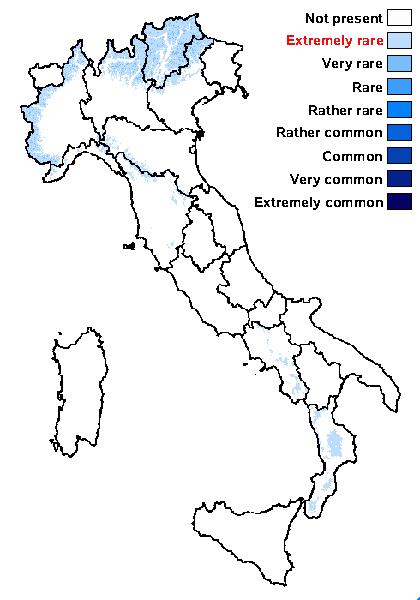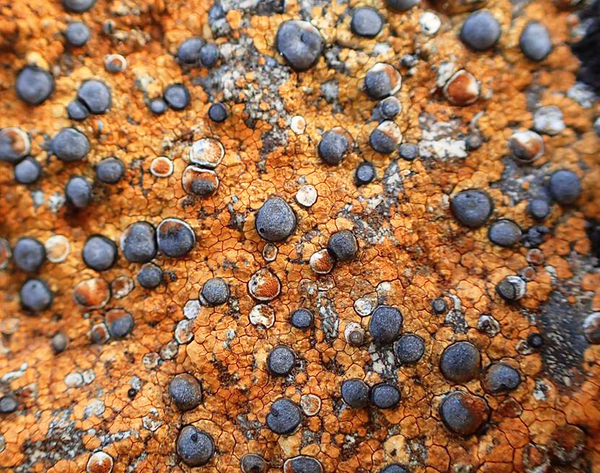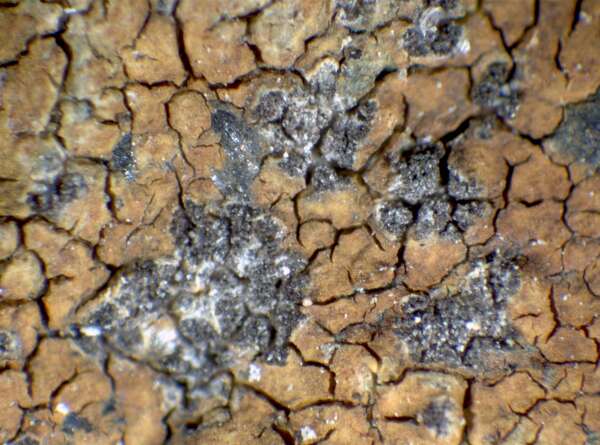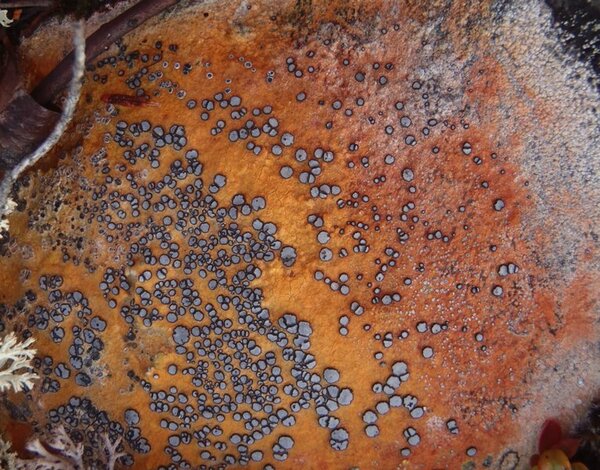Porpidia flavicunda (Ach.) Gowan
Bryologist, 92: 43, 1989. Basionym: Lecidea flavicunda Ach. - Lichenogr. Univ.: 166, 1810.
Synonyms: Biatora flavocoerulescens (Hornem.) Hepp; Haplocarpon flavocaerulescens (Hornem.) V. Wirth ex Hertel; Huilia flavicunda (Ach.) Mas. Inoue; Huilia flavocaerulescens (Hornem.) Hertel; Lecidea contigua var. flavicunda (Ach.) Nyl.; Lecidea flavocaerulescens Hornem.; Porpidia flavocaerulescens (Hornem.) Hertel & A.J. Schwab
Distribution: N - Ven, TAA (Ravera & al. 2021, Nascimbene & al. 2022), Lomb, Piem (Isocrono & al. 2003), Emil (Fariselli & al. 2020), Lig (Brunialti & al. 1999). C - Tosc. S - Camp (Jatta 1909-1911), Cal (Jatta 1909-1911).
Description: Thallus crustose, episubstratic, orange to orange-yellow, sometimes with white or grey patches, smooth to rimose-areolate, delimited by a black prothallus. Medulla white, I-. Apothecia lecideine, black, at first semi-immersed, then sessile with a slightly constricted base, (0.2-)1-2(-4) mm across, with a mostly flat, finally convex, thinly to heavily pruinose, sometimes subgyrose or umbonate disc and a thick, raised, smooth to crenulate, often finally flexuous proper margin. Proper exciple of conglutinated, branched, (2-)3-4 μm thick hyphae radiating from the hypothecium, dark in outer part, much paler within, K-; epithecium olive-brown, granulose; hymenium colourless, 75-120(-140) μm high; paraphyses coherent, branched and anastomosing, slightly swollen at tips; hypothecium colourless or pale yellow-brown in upper part, dark brown in lower part. Asci 8-spored, elongate-clavate, with a thin, outer amyloid layer and a thickened tholus penetrated by a pore, the sides of which are strongly amyloid, Porpidia-type. Ascospores 1-celled, hyaline, ellipsoid, 14-19(-24) x (6-)8-11 μm, with a thin perispore. Photobiont chlorococcoid. Spot tests: cortex K-, C-, KC-, P-, UV-; medulla K/UV+ mauve. Chemistry: thallus with confluentic acid (other chemotypes known from N America).Note: a variable species which can produce both apothecia and soredia, found on siliceous boulders in humid and wind-protected situations, e.g. in deep gorges, or along mountain creeks in woodlands, reaching beyond treeline in the Alps. The Italian material needs revision: some records could refer to P. melinodes.
Growth form: Crustose
Substrata: rocks
Photobiont: green algae other than Trentepohlia
Reproductive strategy: mainly sexual, or asexual by soredia, or soredia-like structures (e.g. blastidia)
Commonnes-rarity: (info)
Alpine belt: extremely rare
Subalpine belt: very rare
Oromediterranean belt: absent
Montane belt: extremely rare
Submediterranean belt: absent
Padanian area: absent
Humid submediterranean belt: absent
Humid mediterranean belt: absent
Dry mediterranean belt: absent

Predictive model
Herbarium samples
Growth form: Crustose
Substrata: rocks
Photobiont: green algae other than Trentepohlia
Reproductive strategy: mainly sexual, or asexual by soredia, or soredia-like structures (e.g. blastidia)
Commonnes-rarity: (info)
Alpine belt: extremely rare
Subalpine belt: very rare
Oromediterranean belt: absent
Montane belt: extremely rare
Submediterranean belt: absent
Padanian area: absent
Humid submediterranean belt: absent
Humid mediterranean belt: absent
Dry mediterranean belt: absent

Predictive model
| Herbarium samples |
 INDEX FUNGORUM
INDEX FUNGORUM
 GBIF
GBIF
 DOLICHENS
DOLICHENS






